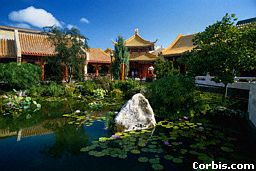 Description
of a Chinese Garden
Description
of a Chinese Garden
To enter a Chinese Garden is a surprise, each step reveals something new and unexpected. The garden itself is made up of many other gardens small and large. The visitor is lead through the garden by pebble-patterned walkways, open doorways, latticed windows and holes in walls. These allow just a glimpse of what else can be expected from the garden. The main feature of a Chinese Garden is the rock and water structures. The next important feature would be the architecture and then the trees, shrubs, and flowers.
The Yin and the Yang are the two forces that the Chinese believe are responsible for all creation. The Yang is the masculine and is represented by the rocks. The Yin is the feminine and is represented by the smooth flowing water. Together these two forces become balanced in the garden creating a beautiful place to be.
The architecture
is a key element in confusing the visitor into believing that the garden
is much larger than it actually is. The types of structures that can be
found are bridges, pavilions and sculptures. These structures are incorporated
into the landscape so well that it actually deceives the visitor as to
the size of the garden. This is done by holes in walls that look into other
rooms of the garden and the winding paths that lead to different areas.

The planting of
trees, shrubs and flowers increases the layering effect of the space. The
types of trees and shrubs that are used in a Chinese Garden depend on the
area that you are dealing with. According to Chinese legend a garden is
not complete without "The Three Friends of Winter"; pine, plum and bamboo.
Plants that are used in Chinese Gardens have some type of symbolic or literary
association involved with them. They do not choose a plant just because
it looks pretty, but for the cultural aspect.